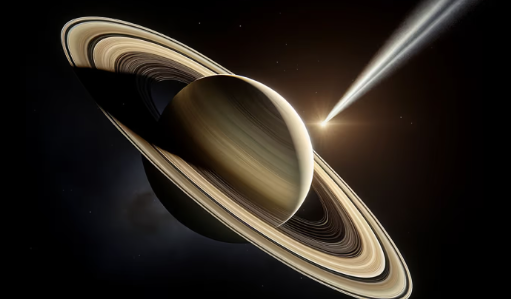Blog Credit : Trupti Thakur
Image Courtesy : Google
Comet A117uUD
In 2024, scientists made a significant discovery when they announced that comet A117uUD had been ejected from our solar system after a close encounter with Saturn.
Discovery of Comet A117uUD
The comet, A117uUD, was discovered by the Asteroid Terrestrial-impact Last Alert System (ATLAS) on June 14, 2024. Researchers studied its path around the Sun using 142 tracking observations.
Impact of Saturn’s Gravity
In 2022, A117uUD had a close encounter with Saturn. The planet’s strong gravity changed the comet’s path, sending it into a very elongated orbit and eventually ejecting it from the solar system at a speed of about 10,800 km/h. This event is only the second time scientists have documented a comet being thrown out of the solar system by a planet’s gravity. The first time was with Comet C/1980 E1 (Bowell) and Jupiter in 1980.
Insights from the Ejection
Studying A117uUD’s path provides valuable insights into how gravity affects objects in space. This event suggests that comet ejections might happen more often than previously thought, challenging the idea that they are rare. As A117uUD travels into interstellar space, it joins a growing list of objects from outside our solar system, helping scientists learn more about space mechanics and the chances of future encounters with similar objects.
Role of ATLAS
The ATLAS system played a crucial role in discovering and monitoring A117uUD, highlighting its importance in expanding our knowledge of the solar system and unusual celestial events. Scientists will continue to observe A117uUD to uncover more mysteries about our solar system and prepare for possible future encounters with interstellar objects.
Saturn Facts:
- Size and Rings:Saturn is the second-largest planet in our solar system, famous for its spectacular rings made of ice and rock.
- Moons:It has 83 confirmed moons, with Titan being larger than the planet Mercury.
- Winds:Saturn’s winds can reach speeds of 1,100 miles per hour.
- Composition: It is a gas giant primarily made of hydrogen and helium.
- Density: Despite its size, Saturn is so light that it could float in water.
- Color:The planet’s yellowish color comes from ammonia crystals in its atmosphere.
A pair of astrophysicists from Ciudad Universitaria and Universidad Complutense de Madrid, both in Spain, report evidence that comet A117uUD was put on its current “hyperbolic trajectory” when it passed close to Saturn two years ago.
In their study, published in Research No
tes of the AAS, Carlos de la Fuente Marcos and Raúl de la Fuente Marcos, analyzed observational data and created a model to trace the path of the comet and track the origin of its current trajectory.
Comet A117uUD was first observed two months ago by a team with the Asteroid Terrestrial-impact Last Alert System. Since that time, other organizations have made 142 observations of the comet, leading to the finding that it is on a “hyperbolic trajectory”—meaning that it will leave the solar system at some point in the foreseeable future. This finding was based on its path over the past two months and the speed at which it is traveling, which is much faster than comets that continue to circle the sun.
The researchers studied all the available data for the comet to build a model that allowed them to unwind the path the comet had taken over the past two years. They found that it had traveled near Saturn in 2020, which would explain its high speed and likely change in heading.
When smaller objects, such as comets, come near a larger spinning object, such as a planet, some of the planet’s momentum is transferred to the smaller object, increasing its Speed and slightly slowing the planet’s orbit.
The researchers also noted that the close pass by Saturn had made it nearly impossible to trace its path prior to the encounter, though they suggest it is not likely that it originated outside the solar system.
This finding of a comet on a hyperbolic trajectory is only the second that has ever been observed— Comet C/1980 E1 was found to be on an escape path back in 1980.
Blog By : Trupti Thakur

07
AugComet A117uUD
Aug 07, 2024Recent Blog
Vikram 3201 & Kalpana 3201Apr 04, 2025
The Open Weight Language ModelApr 03, 2025
Asia Cup 2025Apr 02, 2025
The CrocodilusApr 01, 2025
SARATHIMar 31, 2025




